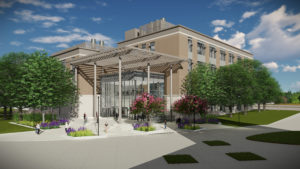Ground broken for plant pathology, microbiology building at Texas A&M
Writer: Kathleen Phillips, 979-845-2872, [email protected]
Contact: Dr. Sandy Pierson, 979-845-7311, [email protected]
COLLEGE STATION — Ground was broken on the Texas A&M University West Campus in College Station Thursday for a $49 million Plant Pathology and Microbiology building, scheduled to be completed by May 2019.
“This building will help us to address our grand challenges of feeding our world, protecting our environment, enriching our youth, improving our health and growing our economy,” said Dr. Mark Hussey, vice chancellor and dean of agriculture and life sciences at Texas A&M.
When the building is completed, 13 of the 14 departments of the College of Agriculture and Life Sciences will be on the West Campus, Hussey noted. In 2008, an effort began to centralize all of the agriculture and life science components. Four new buildings have been added as a result.

“What makes these buildings special is that they serve as a central home for one of Texas A&M’s founding colleges and as a statewide hub for our agricultural agencies,” he added. “Together, our more than 4,800 employees touch the lives of Texans and beyond.”
The plant pathology and microbiology department dates to more than 100 years ago when Dr. J.J. Taubenhaus was hired in 1916 to be Texas A&M’s first plant pathologist. The department now has more than 35 faculty located on campus and around the state at Texas A&M AgriLife Research and Extension centers.
Dr. Sandy Pierson, plant pathology and microbiology department head, said plant pathology and microbiology faculty perform research on a wide diversity of plant-microbe interactions, including plant immunity, biocontrol, pathogenicity mechanisms, plant signaling and volatiles, mycotoxins, programmed cell death and biofuels.
“Through these approaches, we hope to better understand how the plant microbial community — its ‘microbiome’ — determines crop health and the plant’s ability to resist stresses such as disease, drought, poor water quality and low soil nutrients,” Pierson said.
The new building will feature classrooms and a “front porch” on the first floor. The 84,000-square-foot building will consist of a four-story laboratory wing and a three-story teaching and departmental office wing, Hussey said.
Pierson said programs leading to careers in plant pathology, microbiology and bioenvironmental sciences are offered through the department. Additionally, graduate students may specialize in such areas as plant microbiology, genomics, disease management, microbial ecology and molecular plant-microbe interactions.
“A central theme of the new building is ‘Science on Display.’ This building will greatly increase our ability to compete and perform world-class research in plant pathology. It will also enhance our student’s educational experiences — from the 300-seat 21st-century lecture hall to the plant pathology and microbiology teaching laboratories to the bioenvironmental sciences experiential learning laboratory and our modern research laboratories and rooftop greenhouses,” Pierson said. “These facilities will enhance the recruitment and training of the plant pathologists and environmental specialists needed to allow Texas to grow economically while maintaining environmental sustainability.”
Michael Jochum Jr., a current plant pathology and microbiology graduate student, said the building will help him and other students delve even more deeply into their major.
“With the help of erudite scholars of the department, my eyes have been opened to advanced concepts in molecular biology and plant pathology,” said Jochum, who is studying beneficial microorganisms to increase drought tolerance in grasses along with the use of unmanned aerial vehicle-based imagery in rice cropping systems. “I am now using these concepts to push the boundaries of known science and gain insight into the inner complexities of the microbiome.
“This building will stand as a flagship and proud symbol of all our hard work to develop and pass on knowledge to the next generation of environmental professionals and academic scholars.”
The building will be located between the Horticulture/Forest Science Building and the Rosenthal Meat Science and Technology Center.
For more information about the department, see https://plantpathology.tamu.edu/.


